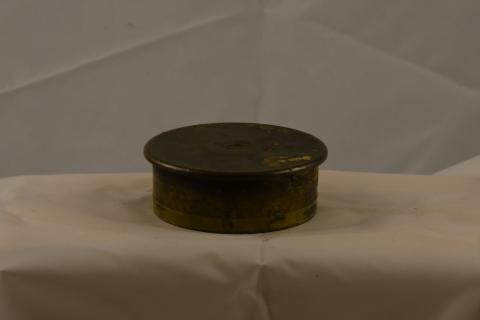This is a piece of trench art that was crafted from the bottom portion of a German 7.7cm feldkanone 96 artillery shell discarded during the First World War. It measures 1.25" (3.2cm) in height by 3.5" (8.9cm) in diameter. It is made of brass, with a metal filing on the interior surface of the top rim. This filed surface serves to slide this piece over the rim of its accompanying piece to form a container. The inscriptions on the bottom of the shell casing show that it was manufactured in October of 1917, making it two years older than its accompanying piece. Other inscriptions are "H.L. 164"; "St"; "67% Cu"; and "HL 35." The outer surface of the rim features a band of transparent tape adhered around it, indicating that someone attempted to tape the two components of the piece together at an unknown point in time. Trench art was a form of art that was produced using spent shells and other used items from the trenches of World War One. Many of the countries that participated in the war produced pieces of art crafted out of spent munitions, particularly Turkish and Chinese participants. Pieces of trench art were not only decorative, however; they could be utilized in a variety of ways for a variety of practical purposes, such as ash trays, tobacco containers, rings, and even lighters. This content can be used with the following resources: SS-WH.9-12.26: Iowans Influence World History SS.3.28: Cultural Contributions This content can be used to educate students on the cultural contributions that Iowa artists made during the First World War, particularly in the field of trench art. Many pieces of authentic trench art have made their way back to the United States and the Midwest, making them important pieces of cultural iconography that symbolize the artistic aspects of the war for those who participated in it. For any use other than instructional resources, please check with the organization that owns this item for any copyright restrictions.
2018.002.032 [Artwork]
Legal Status
Copyright to this resource is held by the Iowa Masonic Library and Museum and has been provided here for educational purposes only, specifically for use in the Iowa Museum Association's "Teaching Iowa History" project. It may not be downloaded, reproduced or distributed in any format without written permission from the Rights Holder. For more information on U.S. and International copyright laws, consult an attorney.

